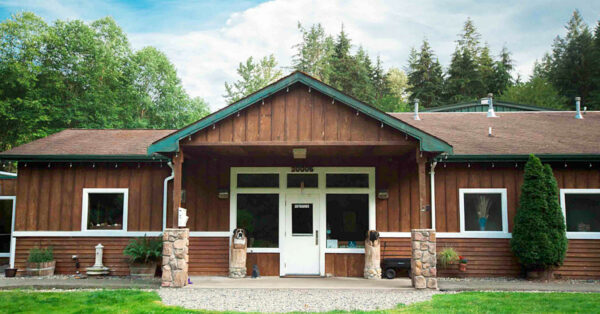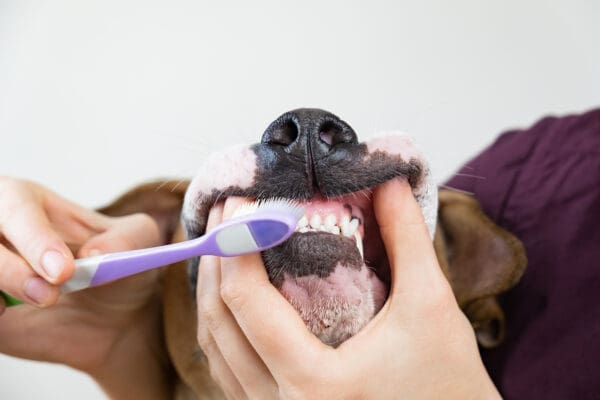
11401 NE 195th St. Bothell, WA 98011
(425) 486-9000 PHONE (425) 486-9002 fax
Natural History
The Brazilian rainbow boa (Epicrates c. cenchria), or BRB, is a semi-arboreal, slender-bodied snake native to Peru, Venezuela, Surinam, and, of course, Brazil. Their namesake comes from the fact that their scales possess microscopic ridges on their surfaces, which act like prisms to reflect light. The result is brilliant rainbow iridescence on the scales. Because of their beautiful colorations, they are often sought after as pets, but their humidity requirements and sometimes-nippy temperament may deter some would-be owners from keeping them.
Females are typically larger than males, often reaching 6-7 feet in length, while males generally top out at around 4-5 feet. These snakes are ovoviviparous, meaning that the gravid females will nourish their eggs inside their bodies and give birth to live babies. Newborns are 15-20 inches in length, and usually very feisty.
Husbandry
Housing: Neonates and smaller BRBs thrive in plastic tub containers with very little ventilation; the containers should always have condensation on the sides. Paper towels as bedding will retain moisture and are easy to change out. Adults should be allowed a 4 to 6 square foot floor space, preferably fully enclosed with limited ventilation (glass aquariums with screen tops are not recommended as they do not retain humidity well). Be aware that with high humidity comes the risk of mold, so it is important to change out any bedding whenever it is soiled. Maintain a spotless cage. Water dishes should be large enough for the snake to curl up in entirely to promote soaking. It is recommended that the water dish be placed directly under a heat lamp, as this will aid in evaporation and thus improve the overall humidity of the cage. The bottom of the cage should be lined with reptile carpet, newspaper, paper towels, or recycled paper because these substrates are easy to clean. Wood chips/shavings, coconut husk, and soil are generally not recommended as substrates, as these are harder to keep clean and can lead to respiratory issues. Hiding spots large enough for the snake to curl up in completely should be provided in both the cool and warm ends of the enclosure. BRBs are solitary animals; except during breeding season, they do not associate with other snakes. It is not recommended to house more than one snake together unless you are actively trying to breed them.
Heating/Lighting: Enclosure temperatures should allow a gradient of 75-83F, and should not exceed 85F for extended periods of time. BRBs can tolerate lower temperatures better than many other boas, but excessive heat can quickly kill them. Appropriate heating elements are ceramic heat emitters or various heat bulbs (provided that any light-emitting heat bulbs are turned off at night), or under tank heaters attached to thermostats. The heat source should always be placed outside the cage, as snakes may curl up around it and burn themselves if they have access to it. “Hot rocks” should not be used, as they often lead to severe burns. It is important to purchase a temperature gun, or digital thermometers that possess probes, for accurate temperature readings. Plastic dial thermometers, or any thermometer with a fixed placement, are often unreliable, and do not adequately gauge thermal gradients inside entire enclosures.
Humidity: The humidity requirements for the Brazilian rainbow boa are specific and tantamount to the success of this species in captivity. Neonates and sub-adult BRBs require a humidity of approximately 95%, while adults, being more tolerant, can be sustained at 75%. Humid hides made out of Tupperware, Rubbermaid, or other appropriately sized plastic tubs, should be provided for adults. These hides should be covered with approximately 1-2 inches of damp sphagnum, peat, or green moss, and should be changed out whenever soiled. Enclosed cages with limited ventilation will retain humidity better than cages with screen tops. Water dishes should be wide, preferably large enough for the snake to soak in, and placed under a heat source to promote evaporation. They must be kept scrupulously clean. If the snake is too large for soaking in its bowl, the animal should be removed from the cage and soaked at least once weekly in a tub of tepid water. If a BRB’s cage is set up correctly, daily misting is not necessary.
Diet
BRBs rarely turn down a meal, even while shedding. They should be fed appropriately sized rats or mice, no larger than the largest part of the snake’s own girth. Newborns can eat hopper mice or rat pinkies, while full-grown females will readily take jumbo rats. A feeding schedule of every 5 days to once a week is suitable for baby BRBs, while adults can be fed once every 7 to 10 days. It is healthier for a snake to eat smaller portions more frequently than it is to feed larger portions less frequently. All BRBs should be fed pre-killed prey for the safety of the snake. Previously killed, frozen prey should be thawed completely to room temperature before feeding. Never feed prey that is still frozen, and never use a microwave to heat the frozen prey.
We advise feeding snakes in a separate (secure) box that is not their main cage. Snakes fed in their cage can come to associate the lid or door opening with food, and may strike at your hand when reaching in to clean or to take the snake out for some other purpose. Instead of feeding in the cage, place the snake in a separate box in a dim, quiet area to let them feed in peace. They may need to remain there for several hours before feeling comfortable enough to eat.
Handling
Brazilian rainbow boas are well known for being nippy as babies, and bites from adults can be somewhat painful due to their long teeth. Regular, gentle handling can condition any snake to your presence, however, and it is recommended to start handling them early while their teeth are small and harmless. Be sure not to handle a snake that is having difficulty feeding or just after it has been fed, as too much activity can stress them out.
Common Medical Issues
Respiratory: Excessive dryness, cool temperatures, or even continued exposure to a dirty environment can all lead to the infection of a snake’s respiratory system. Young BRBs are especially susceptible to respiratory problems because their high humidity requirements are often times not met. If you notice that your snake is breathing with its mouth open, making noises during breathing, or exhibiting discharge or bubbles from its nostrils or mouth, contact a reptile veterinarian immediately.
Shedding: Shedding problems are common with snakes that are ill or suffering from improper husbandry. A healthy, well-kept snake should shed their skin in one single piece, including the caps over their eyes. If the shed breaks into multiple pieces as the snake moves around, that is fine as long as none of it remains sticking to the snake. If your snake is having difficulty clearing the whole shed, we recommend a veterinary exam.
Scale rot: With damp substrates such as moss or dirt, the risk of scale rot is higher than it might be with paper towels, but the biggest cause of this issue is an improperly cleaned cage. Snakes that are allowed to live for days or weeks on end on flooring soaked with excrement are likely to develop bacterial infections, which, if left untreated, can be fatal. Scale rot will show up as reddish brown ulcerations on the snake’s belly, and will begin to erode the scales themselves if left untreated.
Parasites: Internal parasites in the gastrointestinal tract can be present in any snake and can exacerbate an already ill animal’s problems. The best way to prevent this from being an issue is to have yearly fecal exams with your veterinarian while maintaining excellent husbandry at home. Snakes can get these parasites from their food, their environment, and from each other. External parasites, such as mites and ticks, need to be treated immediately, as they can be vectors for fatal viral diseases.
Anorexia: Inadequate temperatures, improper cage size, going into shed, reproductive activity, or simply being offered a food that is different than normal can sometimes upset a snake into refusing food. Careful monitoring of any snake who refuses food is recommended to assess whether or not other symptoms of sickness are showing, and persistent anorexia warrants a veterinary visit.
Injuries From Prey: Feeding live prey to a snake can sometimes have tragic results. When a snake is reluctant to eat for whatever reason, rodents that are left in the cage can chew on the snake’s skin and remove large chunks of skin/scales. They can also deliver damaging bites when the snake attempts to asphyxiate them, sometimes injuring the snake’s head and causing lifelong deformities. In some cases, these bites can be fatal. It is recommended that snakes be fed pre-killed prey to prevent any injuries.
March 30, 2015
Content of this Care Sheet Courtesy of:
The Center for Bird and Exotic Animal Medicine
11401 NE 195th St. Bothell, WA 98011
(425) 486-9000 PHONE (425) 486-9002 fax



